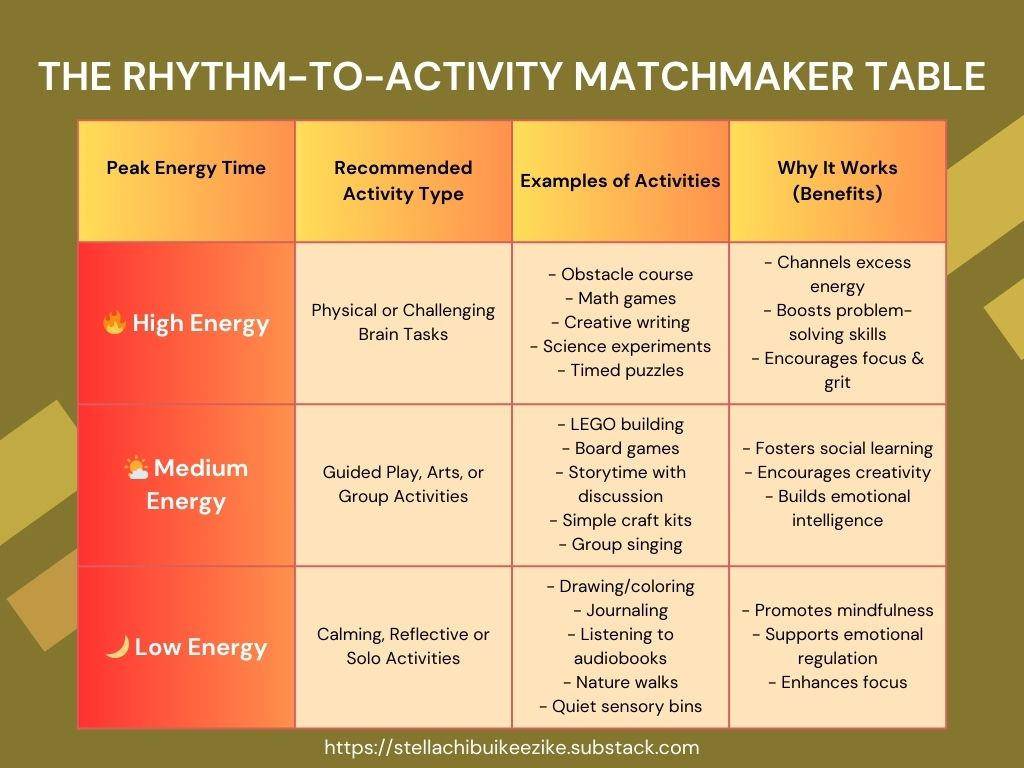Why Learning Struggles Don’t Have to Last (And What You Can Do About It)
Stop Forcing Learning. Start Fostering It Naturally.
This article is part of the Learning Safari track where we turn everyday moments into powerful learning adventures—helping you spark creativity and discovery in your child’s everyday world.
The Secret to Sticky Learning? It’s All in the Rhythm
As parents, we often feel like we’re in a race—pushing our kids to learn faster, better, more.
But what if the secret to effortless learning isn't about how much we push, but about tuning into their natural rhythms?
Learning isn’t a one-size-fits-all approach.
Every child is different, and their brains, like ours, have their own rhythm.
They process new ideas and information in waves, with peaks and valleys.
Some thrive in the morning, while others light up after sunset.
Some need to move first before they can focus, while others crave a calm environment to think.
It’s more about recognizing what helps the learning to stick, and that’s where rhythm comes in.
That’s why finding their rhythm is key to fostering a love for learning.
This week on our Learning Safari, we’re diving into understanding your child’s unique learning rhythm and how honoring it can make learning feel effortless.
Want more tools to help you build intentional rhythms and create a thriving learning environment at home?
Unlock the full Becoming Together Premium Experience and go deeper with practical guides, community support, and exclusive resources to help you and your child grow—together.
Noticing My Children’s Learning Rhythms
It didn’t happen overnight, but eventually, I started seeing something I’d missed before.
My 6YO thrives with movement. She can’t sit still for long and gets restless, so forcing her into hours of quiet study time felt like a struggle for both of us. But when I took a step back, I realized: She learns better when she’s moving!
My 8YO is a morning person. She wakes up ready to go, full of energy and focus. She loves starting her day early, which makes her prime learning time in the first few hours of the morning.
And now, here’s the magic part: despite their differences, both of them now enjoy quick, focused learning sessions first thing in the morning.
It’s not about forcing them into a mold. It’s about recognizing what works for them and adapting.
Why Rhythm Matters
You know those mornings when you’re feeling off, and you can tell your child is too?
That’s your clue that their learning rhythm might not be in sync with what they’re being asked to do.
Instead of pushing harder, I’ve learned that when we honor their rhythms, the natural flow of learning happens.
So how can we tap into this rhythm? Let’s break it down:
Morning Learners: These kids are at their best in the early hours. They love diving into challenging tasks, creative play, or exploration first thing. If this is your child, leverage their morning energy for focused activities.
The Movers: For others, movement is a must. These kids can’t sit still, and that's okay! A quick run or dance break can prepare their brains for more focused learning. Movement is brain food.
Night Owls: Some children find their rhythm after the sun goes down. They become more creative, more engaged. This is the time for them to dig into arts, storytelling, or open-ended projects.
The Rhythm Observation Exercise
Over the next couple of days, pay attention to when your child is most focused, energized, or engaged.
Write down your observations and see if a pattern starts to emerge.
Here’s what to look for:
Time of Day: Are they most energized in the morning, or do they peak later in the day?
Activity Type: Do they concentrate better when moving, or do they need to sit still?
Energy Flow: Do they need a physical activity first (like a walk or jump) before tackling a mental task?
By understanding these patterns, we can create learning opportunities that match their natural flow.
A Quick Story
Last school term, my 6YO was struggling with telling time on an analog clock.
It was a tricky concept for her, and she was starting to get frustrated.
And, if I’m being honest, I was feeling the frustration too!
So, we decided to shut the books, and instead, we went for a walk.
No drills. No pressure. Just space to breathe.
When we came back? She answered 8 out of 10 questions correctly.
Concepts that had felt impossible minutes before clicked effortlessly.
What changed?
A break allowed her brain to organize the information naturally.
Movement cleared the mental fog.
Ownership and self-discovery brought back the curiosity and confidence.
Now, I always keep this in mind:
When we hit a learning wall, instead of pushing harder, we step back and trust the process.
This is where growth happens.
The Takeaway: Learning Doesn’t Have to Be a Struggle
So, if your child is struggling with a concept or task, maybe it’s not about doing more.
It might be about doing less or doing it in a different way.
Here’s how you can try this at home:
Notice your child’s rhythm. When are they at their best? What times of day do they thrive?
Create a small window for learning during their peak energy time. Whether it’s 15 minutes or 30 minutes, keep it short and engaging.
Incorporate movement — whether it’s a quick walk, stretching, or a fun game. Movement often helps ideas “click.”
Take breaks when you hit a wall. Give your child space to breathe. It’s okay to step back for a moment and return with fresh energy.
Your Turn
Have you ever had a moment like this, where stepping back and embracing your child’s rhythm made a difference?
I’d love to hear your thoughts, struggles, or successes in finding your child’s learning flow.
Let’s chat and share our experiences!
See you around,
Stella ✨
🎁 Bonus: The Rhythm-to-Activity Matchmaker Table
Turn Energy into Engagement. Align Activities with Your Child’s Natural Flow
Want to make it more fun?
Let your child help match their mood to an activity using this table—it builds awareness and autonomy!
You can even print it out and let them stick emoji stickers next to how they’re feeling that day.
💫 Want to Make Rhythm Your Reality?
If today’s article resonated with you—if you’ve been thinking,
“Yes, I want to understand my child better… but where do I even begin?”
—then the Premium Becoming Together was made for you.
Because thriving children start with thriving parents.Inside, we don’t just talk about ideas—we build rhythms, routines, and realities that support your growth and your child’s learning.
🔓 Unlock access to:
Chapter-by-chapter deep dives from Family Time Unplugged
Playbooks, habit trackers & tools to support your parenting flow
A private chat space for weekly focus challenges & support
Implementation videos, curated libraries, and progress trackers
Direct Q&A access to me—so you’re never figuring it out alone
✨ Whether you’re just starting or finding your flow again, you deserve tools that move you forward—with purpose and peace.
👉 Join Premium for just $10/month or $72/year and begin building the rhythm that works for you.
Let’s become—together.







This was insightful for me as an adult too. Thanks for the reminder to embrace our learning style.